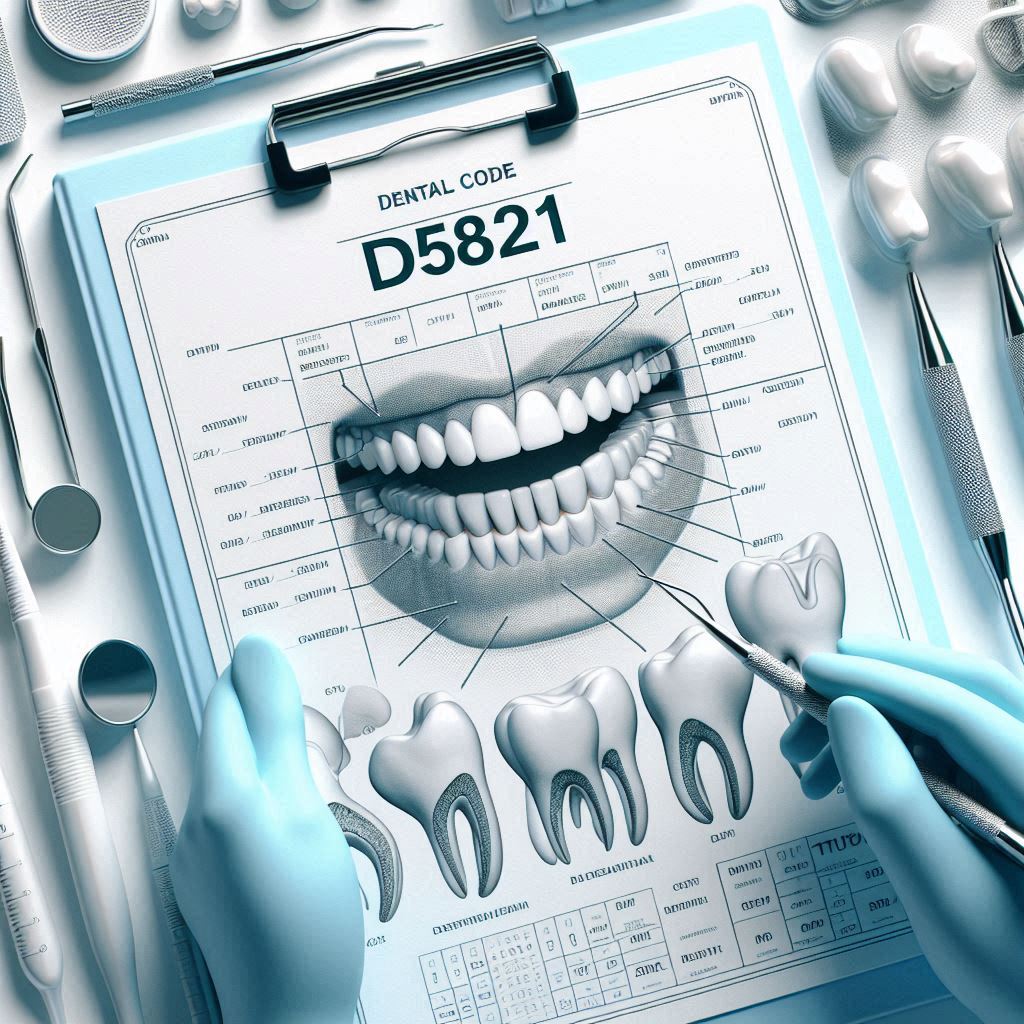D5821 Dental Code
Losing one or more teeth can significantly impact a patient’s oral function, aesthetics, and self-confidence. While permanent solutions like implants or fixed bridges are ideal, they often require time for healing and fabrication. This is where interim partial dentures (D5821) come into play—providing an immediate, temporary, yet functional solution.
This comprehensive guide explores the D5821 dental code, detailing its purpose, benefits, fabrication process, and how it compares to other dental prostheses. Whether you’re a dental professional or a patient seeking clarity, this article will provide in-depth insights into interim partial dentures.

2. What is the D5821 Dental Code?
The D5821 dental code is used by dentists and insurance companies to classify interim partial dentures—flipper dentures or temporary partial dentures designed for short-term use. These prostheses are typically made from acrylic and replace one or more missing teeth until a permanent restoration (e.g., implants or fixed bridges) can be placed.
Key Features of D5821 Interim Partial Dentures:
- Temporary solution (usually 3–6 months)
- Lightweight and removable
- Made from acrylic resin
- Less expensive than permanent options
3. Indications for Interim Partial Dentures (D5821)
Interim partial dentures are recommended in various clinical scenarios:
✅ Post-extraction healing – Used after tooth removal while waiting for gum healing.
✅ Pre-prosthetic phase – Acts as a placeholder before permanent prosthetics (e.g., implants).
✅ Aesthetic concerns – Helps patients maintain a natural smile during treatment.
✅ Functional needs – Provides chewing ability while waiting for long-term solutions.
4. Types of Interim Partial Dentures
Interim partial dentures can be classified based on:
| Type | Description |
|---|---|
| Acrylic Flipper | Lightweight, removable, made entirely of acrylic. |
| Cast Metal Frame | More durable, includes a metal framework for added stability. |
| Flexible Partial | Made from nylon-based materials (e.g., Valplast), offering better comfort. |
5. Materials Used in Interim Partial Dentures
The most common materials include:
- Acrylic resin – Affordable and easy to adjust.
- Polycarbonate – More durable than acrylic.
- Flexible thermoplastics – Comfortable but less rigid.
6. The Process of Fabricating an Interim Partial Denture
- Initial Consultation – Dentist evaluates the need for an interim denture.
- Impressions – Molds are taken of the patient’s mouth.
- Wax Try-In – A wax model is tested for fit.
- Acrylic Processing – The final denture is fabricated in a dental lab.
- Delivery & Adjustments – The dentist ensures proper fit and comfort.
7. Benefits of Choosing D5821 Over Other Dental Codes
✔ Immediate tooth replacement
✔ Cost-effective compared to permanent options
✔ Non-invasive (no surgery required)
✔ Easy to modify if further dental work is needed
8. Potential Challenges and Limitations
- Not as durable as permanent prosthetics.
- May require adjustments as the mouth heals.
- Can affect speech initially.
9. Cost and Insurance Coverage for D5821
- Cost: 300–300–800 per arch (depending on materials).
- Insurance: Many plans cover D5821 as a temporary solution.
10. Maintenance and Care for Interim Partial Dentures
- Clean daily with a denture brush.
- Soak overnight in a denture solution.
- Avoid hot water to prevent warping.
11. Comparison Between D5821 and Other Dental Prosthesis Codes
| Code | Description | Duration | Cost |
|---|---|---|---|
| D5821 | Interim Partial Denture | 3–6 months | 300–300–800 |
| D5214 | Mandibular Partial Denture (Metal) | 5+ years | 1,500–1,500–3,000 |
| D6010 | Dental Implant (Single) | Permanent | 3,000–3,000–5,000 |
12. Patient Experiences and Case Studies
Case Study 1: A 45-year-old patient received a D5821 flipper after molar extraction. The denture provided functionality until an implant was placed six months later.
Case Study 2: A young adult used an interim partial denture after an accident, maintaining aesthetics while awaiting a permanent bridge.
13. FAQs
Q1: How long can I wear an interim partial denture?
A: Typically 3–6 months, but your dentist will advise based on your treatment plan.
Q2: Will insurance cover D5821?
A: Many plans do, but coverage varies—check with your provider.
Q3: Can I eat normally with an interim denture?
A: Soft foods are recommended initially; avoid sticky or hard foods.
14. Conclusion
The D5821 dental code provides an essential temporary solution for patients needing immediate tooth replacement. While not a permanent fix, interim partial dentures offer functionality, aesthetics, and affordability during transitional phases. Consulting with your dentist ensures the best choice for your dental needs.
15. Additional Resources
- American Dental Association (ADA) Coding Guide
- Journal of Prosthetic Dentistry – Interim Prostheses Research
- Patient Guide to Denture Care (FDA)


